SWEDISH SOUTH ASIAN STUDIES NETWORK
Bangladesh
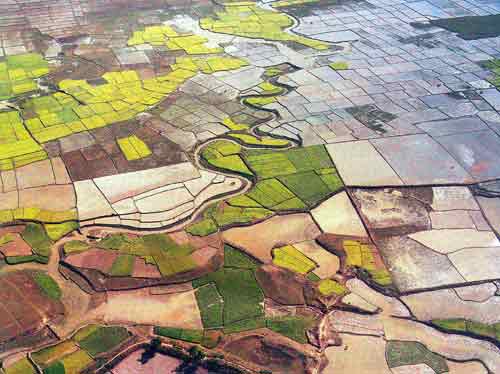 Official name: People's Republic of Bangladesh (Gana
Prajatantri Bangladesh)
Official name: People's Republic of Bangladesh (Gana
Prajatantri Bangladesh)
Area: 143.988 sq.km
Administration: The country is divided into six divisions
– Dhaka, Chittagong, Rajshahi, Barisal, Sylhet and Khulna. See
administrative map of Bangladesh.
Capital: Dhaka
Independence: 26 March, 1971, from Pakistan. Internationally
recognized on 16 December, 1971
Population: 141,340,476 (July 2004 est)
Population growth: 2.08 p.c (2004 est)
Life expectency: 61,7 years
Literacy rate (age 15 and over who can
read and write): 43.1%
Per capita GDP: purchasing power parity – 1
900 US-dollars (2003 est)
Population below poverty line: 35.6 p.c (FY95/96
est.)
Industries: Cotton textiles, jute, garments, tea
processing, paper newsprint, cement, chemical fertilizer, light engineering,
sugar
Industrial growth: 4 p.c. (2003 est.)
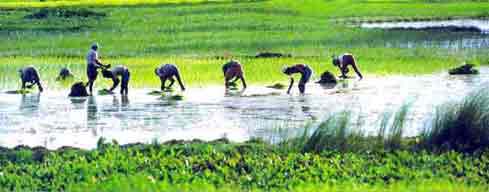 Export
products: Major agricultural products are rice, jute, wheat, potato,
pulses, sugarcane, tea, tobacco. The country is the world's largest exporter
of jute and jute goods. Tea, leather and frozen shrimp are also major
foreign exchange earners. Manufacturing industries offer a wide range
of exportable goods such as leather goods and ready-made garments. Export
of handicrafts is also significant. Remittances from Bangladeshis employed
abroad have contributed significantly toward foreign exchange earnings.
Export
products: Major agricultural products are rice, jute, wheat, potato,
pulses, sugarcane, tea, tobacco. The country is the world's largest exporter
of jute and jute goods. Tea, leather and frozen shrimp are also major
foreign exchange earners. Manufacturing industries offer a wide range
of exportable goods such as leather goods and ready-made garments. Export
of handicrafts is also significant. Remittances from Bangladeshis employed
abroad have contributed significantly toward foreign exchange earnings.
Land use: Arable land: 73 p.c, forest and woodlands
15 p.c.
Ethnic groups: Over 98 percent Bengalis. Approximately
250 000 Biharis (Urdu-speaking, non-Bengali Muslims) and 900 000 members
of tribal minority groups. Main tribal groups Chakmas, Marmas, Tipperas,
and Mros, living primarily in Chittagong Hills Tracts
Religious groups: Muslims 88,3 p.c, Hindus 10,5 p.c,
Buddhists 0,6 p.c, Christian 0,4 p.c, Others 0,2 p.c
Languages: Bangla (official); English widely used
by educated elite. Arabic used in many Muslim homes. The tribal population
speak various tibeto-burman and austro-asiatic dialects.
National flag: Green with a large red disk slightly to the hoist side of center; the red sun of freedom represents the blood shed to achieve independence; the green field symbolizes the lush countryside, and secondarily, the traditional color of Islam
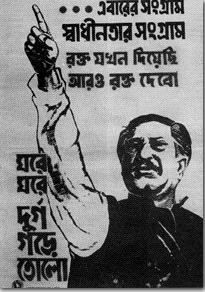 National
anthem: Amar shonar Bangla (musik and lyrics by Rabindranath
Tagore)
National
anthem: Amar shonar Bangla (musik and lyrics by Rabindranath
Tagore)
Legislature: Bangladesh has a 300 seat Parliament,
Jatiya Sangsad. The members are elected for a period of five years. Till
the previous parliament an additional number of thirty seats were reserved
for women, who were nominated, but this provision has been withdrawn.
Legislative power is exercised by the Parliament.
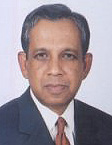 Between January 2007 and December 2008 Bangladesh was governed by a so-called Chief
Advisor, acting as Head of a non-party interim caretaker government of
Bangladesh. The Chief Advisor was Dr. Fakhruddin
Ahmed (photo to the left), a noted Bangladeshi economist,
civil servant, and a former governor of the Bangladesh Bank. He was appointed
by the President amidst chaos in Bangladeshi politics.
Between January 2007 and December 2008 Bangladesh was governed by a so-called Chief
Advisor, acting as Head of a non-party interim caretaker government of
Bangladesh. The Chief Advisor was Dr. Fakhruddin
Ahmed (photo to the left), a noted Bangladeshi economist,
civil servant, and a former governor of the Bangladesh Bank. He was appointed
by the President amidst chaos in Bangladeshi politics.
A general election was held in Bangladesh on 29 December 2008. The two key parties in the election were the Bangladesh Nationalist Party (BNP), led by Khaleda Zia, and the Awami League, led by Sheikh Hasina. The Awami League formed a fourteen-party grand alliance (Mohajot) including Ershad's Jatiya Party, while the BNP formed a four-party alliance which included the Islamist party Jamaat-e-Islami. The election was originally scheduled for January 2007, but it was postponed for an extended period due to protests by the opposition and threats of general boycott.
The election resulted in a landslide victory for the Awami League-led grand alliance, which won 263 seats. The main rival four-party alliance led by Bangladesh Nationalist Party and the Islamist Jamaat-e-Islami Bangladesh received only 32 seats, with the remaining 4 going to independent candidates.
The seats in Jatiya Sangsad:
Grand Alliance:
Bangladesh Awami League 230
Jatiya Party 27
Jatiyo Samajtantrik Dal 3
Workers Party of Bangladesh 2
Liberal Democratic Party 1Four Party Alliance:
Bangladesh Nationalist Party 29
Jamaat-e-Islami Bangladesh 2
Bangladesh Jatiya Party (BJP) 1
President: Professor Dr
Iajuddin Ahmed. He took oath as President
of the Republic on 6 September 2002. Dr Ahmed is a man with a long prestigeous
academic career. He has a Swedish connection, in that he was a Visiting
Professor at Uppsala University in 1984.
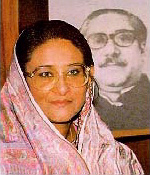 Prime
Minister: Sheikh Hasina Wajed (Awami League). (Photo to the left)
Prime
Minister: Sheikh Hasina Wajed (Awami League). (Photo to the left)
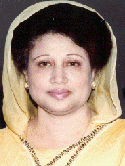 Leader
of the Opposition: Khaleda Zia (Bangladesh
Nationalist Party, BNP), (photo
to the right) was Prime Minister during the period 1990–1996, and 2001–2006.
Leader
of the Opposition: Khaleda Zia (Bangladesh
Nationalist Party, BNP), (photo
to the right) was Prime Minister during the period 1990–1996, and 2001–2006.
Other important political leaders:
Hussain Mohammad Ershad (Jatiyo Party)
Ali Khan (Jamiat-e-Islami)
History: The history of Bangladesh has been one
of extremes, of turmoil and peace, prosperity and destitution. The earliest
mention of Bangladesh is found in the Hindu epic, the Mahabharata. In
the 5th and 6th centuries B.C. came the Aryans from Central Asia and
the Dravidians from Western India. Then came the Guptas, Palas and Senas,
who were Buddhist and Hindus. From the 13th century A.D. the Buddhist
and Hindus were swamped by the flood of Muslim invaders and the tide
of Islam upto l8th century. Sometimes there were independent rulers like
the Hussain Shahi and llyas Shahi dynasties while at other times they
ruled on behalf of the imperial Mughal seat of Delhi.
From 15th century the Europeans – Portuguese, Dutch, French and British
traders – exerted an economic influence over the region. British political
rule over the region began in 1757 A.D.when the last Muslim ruler of Bengal was
defeated at Plassey.
After the end of the British rule In1947 the country was partitioned into India
and Pakistan. Present Bangladesh became the Eastern Wing of the then Pakistan.
But the movement for autonomy for East Pakistan started within a couple of years
because of linguistic and cultural difference and economic disparity between
the two wings. The seeds of independence were sown through the Language Movement
of 1952 to recognize Bangla as a state language.
Ultimately then, the East Pakistan emerged as a sovereign and independent state of Bangladesh in 1971 after nine month-long war of Liberation (starting on 26 March 1971) under the leadership of the Father of the Nation, Bangabandhu Sheikh Mujibur Rahman. He led the country for only four years.
| More information on Bangladesh |
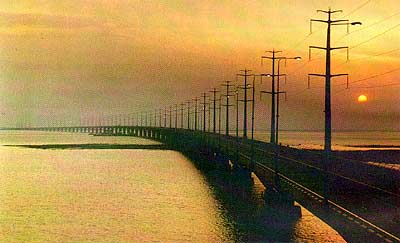
Wikipedia, the free encyclopedia, Bangladesh
BBC News Country Profile Bangladesh
The Human Development Report 2009 data on Bangladesh
Virtual resource centre on Bangladesh, created by Chr. Michelsen Institute, Bergen, Norway.
The Library of Congress, USA, offers through its Country Studies Web site detailed Information on all Aspects of Countries round the Globe. Look for Bangladesh. Information contained in the Country Studies On-Line is not copyrighted and thus is available for free and unrestricted use by researchers. As a courtesy, however, appropriate credit should be given to the series. Unfortunately, though, the information on Bangladesh is not updated since September 1988.
World Bank Group/Bangladesh: Constantly updated data reports, publications, statistics, projects etc, for Bangladesh
CIA –The World Factbook: Bangladesh
Bangladesh Government Official Web Pag
The Swedish Government’s Division for Democratic Issues, based at the Ministry of Justice, regularly publishes reports about the human rights situation in countries all over the World. Read the 2007 Report on the Human Rights Situation in Bangladesh (in Swedish only).
The British Foreign & Commonwealth Office (FCO) advice on safety aspects on travelling to Bangladesh
SASNET - Swedish South Asian Studies
Network/Lund University
Address: Scheelevägen 15 D, SE-223 70 Lund, Sweden
Phone: +46 46 222 73 40
Webmaster: Lars Eklund
Last updated
2010-09-09
